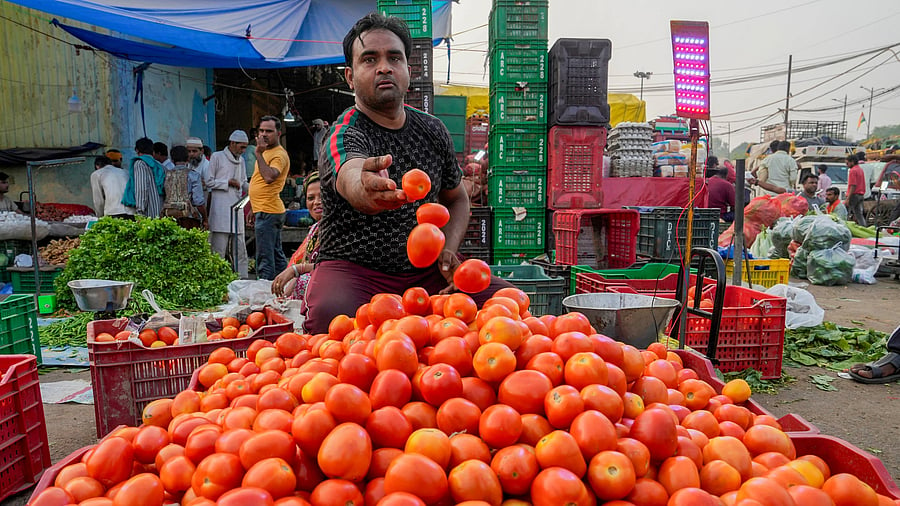
A vendor arranges tomatoes on a cart as he waits for customers at the Okhla vegetable market, in New Delhi.
Credit: PTI Photo
New Delhi: India’s annual retail inflation eased to an over six-year low of 2.10% in June while wholesale prices turned to deflation for the first time in 20 months aided by sustained decline in food, fuel and energy prices, according to official data released on Monday.
This is the fifth consecutive month that the headline retail inflation has stayed below the Reserve Bank of India’s medium-term target of 4%. June also marked the second month in a row when the retail inflation stayed below 3%.
The Consumer Price Index (CPI)-based inflation, which the central bank monitors for its policy rate action, was at 2.82% in May. In June 2024, it was 5.08%, data released by the National Statistics Office (NSO) showed.
The Wholesale Price Index (WPI) turned to deflation after a gap of 19 months. WPI, which tracks price movement in the wholesale markets, recorded a deflation of 0.13% in June from an inflation of 0.39% in May. In June 2024, WPI-based inflation stood at 3.43%, according to the Ministry of Commerce and Industry data.
While inflation shows general increase in prices of goods and services in the economy, deflation refers to the situation when there is a general decline in prices. The official data indicate that the general price level in the wholesale markets in June 2025 was lower when compared with the same month last year.
The consistent decline in inflation has brightened the hope for further easing in the policy interest rates by the RBI.
“We are not ruling out the possibility of a final 25 bps rate cut in the August 2025 meeting, carrying forward the front-loading seen in June 2025,” said Aditi Nayar, Chief Economist, ICRA.
RBI has cut key policy interest rates by 100 basis points (1%) since February. In the June bi-monthly policy review, the central bank’s monetary policy committee (MPC) opted for a larger-than-expected 50 bps cut in policy repo rate.
“With a firmly benign inflationary trend envisaged going ahead, notwithstanding the tumult on part of trade-led restrictions and non-linear pass-through of such vagaries, the plot seems to be spiced with a further 25 bps rate cut (sooner than later) to give an adrenaline boost to the economic juggernaut as global developments necessitate us to build today for tomorrow,” said Soumya Kanti Ghosh, Group Chief Economic Adviser, State Bank of India (SBI).
There was a general decline in food prices. Retail food prices turned into deflation for the first time since February 2019. Food prices declined by 1.1% year-on-year in June, aided by sharp drop in prices of vegetables, pulses and spices.
The prices of vegetables were down 19% year-on-year, the sharpest pace of decline since December 2022. In addition, prices of pulses were down 11.8%, while meat & fish became cheaper by 1.6% year-on-year during the month under review. Cereals inflation fell to a 41-month low of 3.7%.
“The favourable progression of kharif sowing bodes well for the inflation outlook in line with the ongoing trend in food prices. We expect the retail inflation to be in the range of 3%-3.5% in 2QFY26 due to muted inflation in food items,” said Paras Jasrai, Associate Director at India Ratings and Research.
Notwithstanding the deflationary turn of food items, core inflation increased to 4.4% in June 2025, the highest since September 2023.
“We expect the FY26 inflation to undershoot RBIs estimates of 3.7% by around 50 bps,” said Upasna Bhardwaj, Chief Economist, Kotak Mahindra Bank.